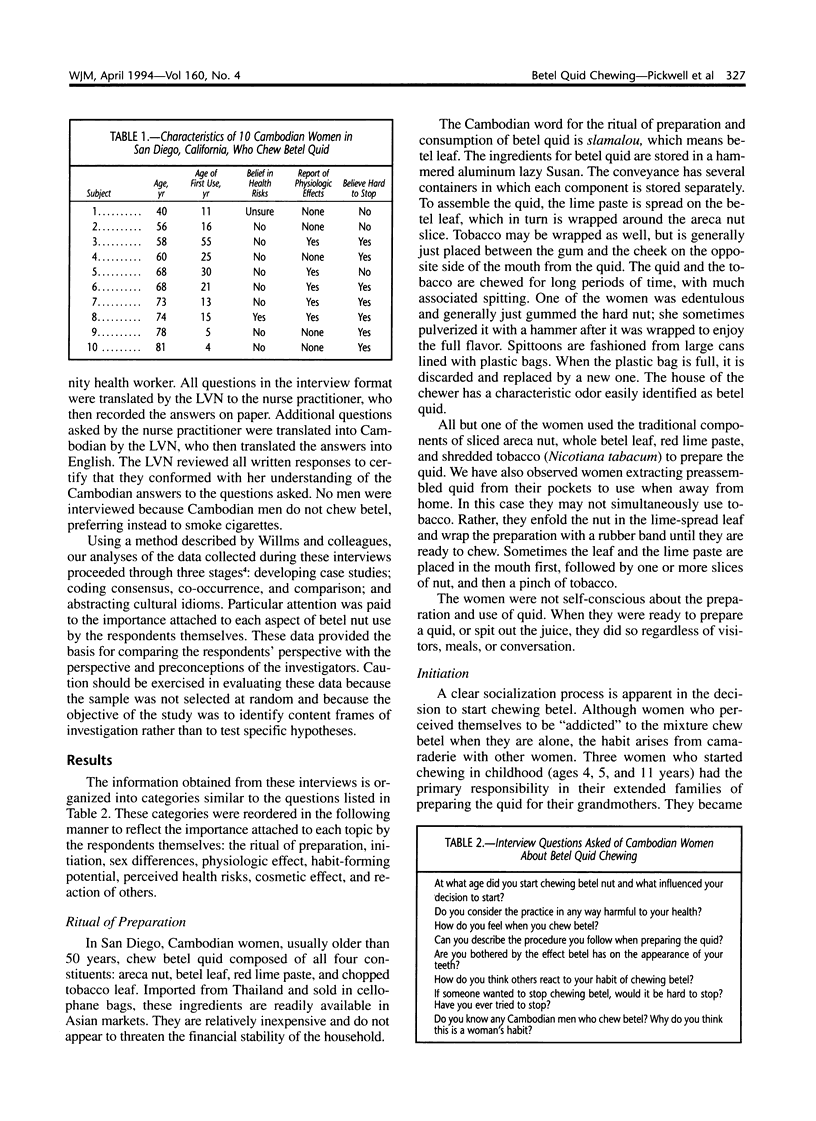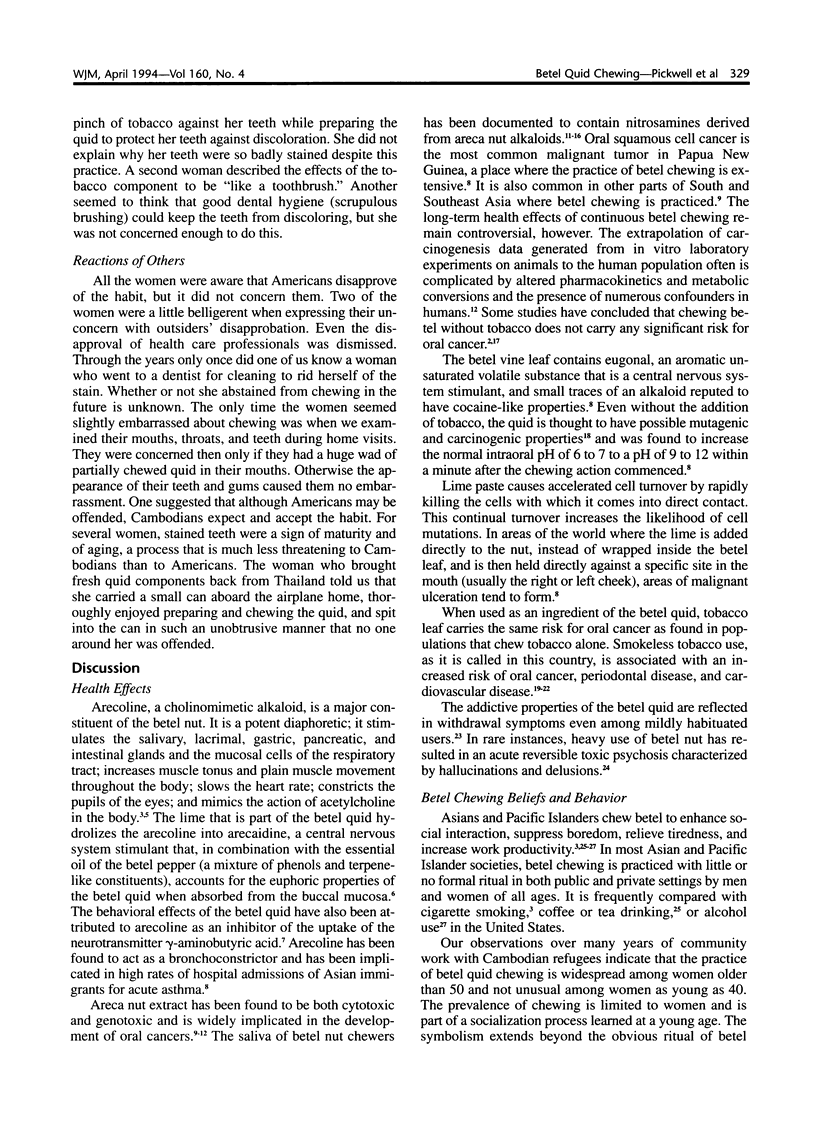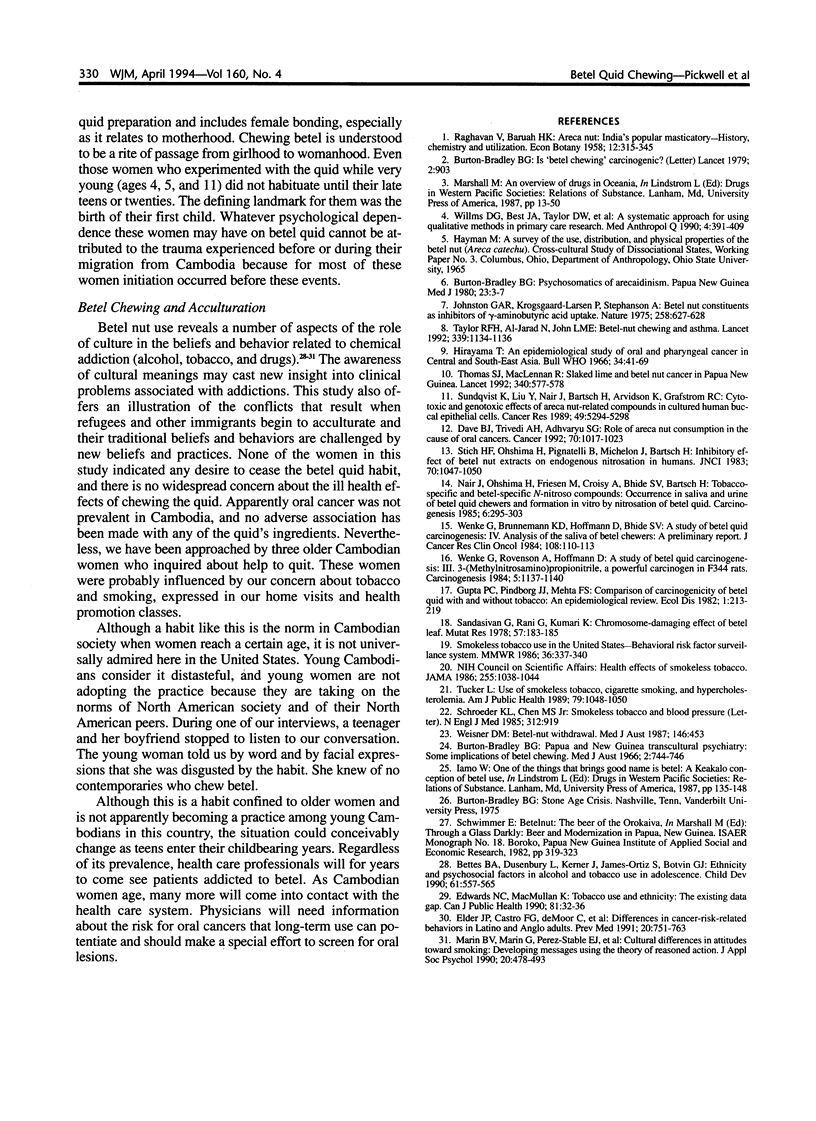Abstract
Although an estimated 10% to 25% of the world's population chews betel quid, this practice is virtually unknown in the United States. Health care professionals coming into contact with immigrants and refugees from India, New Guinea, and Southeast Asia will increasingly notice this habit. Possible hazards associated with the chewing of the various ingredients of the quid include oral cancer and an addictive potential as strong as for cigarettes. We surveyed a group of Cambodian refugee women who are addicted to betel nut and its associated components. Participant-directed interviews uncovered some of the cultural meanings surrounding the ritual of preparing and using the betel quid and the role of culture in the beliefs and behaviors related to chemical addiction.
Full text
PDF




Selected References
These references are in PubMed. This may not be the complete list of references from this article.
- Bettes B. A., Dusenbury L., Kerner J., James-Ortiz S., Botvin G. J. Ethnicity and psychosocial factors in alcohol and tobacco use in adolescence. Child Dev. 1990 Apr;61(2):557–565. doi: 10.1111/j.1467-8624.1990.tb02800.x. [DOI] [PubMed] [Google Scholar]
- Burton-Bradley B. G. Is "betel chewing" carcinogenic? Lancet. 1979 Oct 27;2(8148):903–903. doi: 10.1016/s0140-6736(79)92716-8. [DOI] [PubMed] [Google Scholar]
- Burton-Bradley B. G. Papua and New Guinea transcultural psychiatry: some implications of betel chewing. Med J Aust. 1966 Oct 15;2(16):744–746. doi: 10.5694/j.1326-5377.1966.tb97486.x. [DOI] [PubMed] [Google Scholar]
- Burton-Bradley B. G. Psychosomatics of arecaidinism. P N G Med J. 1980 Mar;23(1):3–7. [PubMed] [Google Scholar]
- Dave B. J., Trivedi A. H., Adhvaryu S. G. Role of areca nut consumption in the cause of oral cancers. A cytogenetic assessment. Cancer. 1992 Sep 1;70(5):1017–1023. doi: 10.1002/1097-0142(19920901)70:5<1017::aid-cncr2820700502>3.0.co;2-#. [DOI] [PubMed] [Google Scholar]
- Edwards N. C., MacMillan K. Tobacco use and ethnicity: the existing data gap. Can J Public Health. 1990 Jan-Feb;81(1):32–36. [PubMed] [Google Scholar]
- Elder J. P., Castro F. G., de Moor C., Mayer J., Candelaria J. I., Campbell N., Talavera G., Ware L. M. Differences in cancer-risk-related behaviors in Latino and Anglo adults. Prev Med. 1991 Nov;20(6):751–763. doi: 10.1016/0091-7435(91)90069-g. [DOI] [PubMed] [Google Scholar]
- Gupta P. C., Pindborg J. J., Mehta F. S. Comparison of carcinogenicity of betel quid with and without tobacco: an epidemiological review. Ecol Dis. 1982;1(4):213–219. [PubMed] [Google Scholar]
- Hirayama T. An epidemiological study of oral and pharyngeal cancer in Central and South-East Asia. Bull World Health Organ. 1966;34(1):41–69. [PMC free article] [PubMed] [Google Scholar]
- Johnston G. A., Krogsgaard-Larsen P., Stephanson A. Betel nut constituents as inhibitors of gamma-aminobutyric acid uptake. Nature. 1975 Dec 18;258(5536):627–628. doi: 10.1038/258627a0. [DOI] [PubMed] [Google Scholar]
- Nair J., Ohshima H., Friesen M., Croisy A., Bhide S. V., Bartsch H. Tobacco-specific and betel nut-specific N-nitroso compounds: occurrence in saliva and urine of betel quid chewers and formation in vitro by nitrosation of betel quid. Carcinogenesis. 1985 Feb;6(2):295–303. doi: 10.1093/carcin/6.2.295. [DOI] [PubMed] [Google Scholar]
- Sadasivan G., Rani G., Kumari C. K. Chromosome-damaging effect of betel leaf. Mutat Res. 1978 May;57(2):183–185. doi: 10.1016/0027-5107(78)90266-x. [DOI] [PubMed] [Google Scholar]
- Schroeder K. L., Chen M. S., Jr Smokeless tobacco and blood pressure. N Engl J Med. 1985 Apr 4;312(14):919–919. doi: 10.1056/nejm198504043121411. [DOI] [PubMed] [Google Scholar]
- Stich H. F., Ohshima H., Pignatelli B., Michelon J., Bartsch H. Inhibitory effect of betel nut extracts on endogenous nitrosation in humans. J Natl Cancer Inst. 1983 Jun;70(6):1047–1050. [PubMed] [Google Scholar]
- Sundqvist K., Liu Y., Nair J., Bartsch H., Arvidson K., Grafström R. C. Cytotoxic and genotoxic effects of areca nut-related compounds in cultured human buccal epithelial cells. Cancer Res. 1989 Oct 1;49(19):5294–5298. [PubMed] [Google Scholar]
- Taylor R. F., al-Jarad N., John L. M., Conroy D. M., Barnes N. C. Betel-nut chewing and asthma. Lancet. 1992 May 9;339(8802):1134–1136. doi: 10.1016/0140-6736(92)90732-i. [DOI] [PubMed] [Google Scholar]
- Thomas S. J., MacLennan R. Slaked lime and betel nut cancer in Papua New Guinea. Lancet. 1992 Sep 5;340(8819):577–578. doi: 10.1016/0140-6736(92)92109-s. [DOI] [PubMed] [Google Scholar]
- Tucker L. A. Use of smokeless tobacco, cigarette smoking, and hypercholesterolemia. Am J Public Health. 1989 Aug;79(8):1048–1050. doi: 10.2105/ajph.79.8.1048. [DOI] [PMC free article] [PubMed] [Google Scholar]
- Wenke G., Brunnemann K. D., Hoffmann D., Bhide S. V. A study of betel quid carcinogenesis. IV. Analysis of the saliva of betel chewers: a preliminary report. J Cancer Res Clin Oncol. 1984;108(1):110–113. doi: 10.1007/BF00390981. [DOI] [PubMed] [Google Scholar]
- Wenke G., Rivenson A., Hoffmann D. A study of betel quid carcinogenesis. 3. 3-(Methylnitrosamino)-propionitrile, a powerful carcinogen in F344 rats. Carcinogenesis. 1984 Sep;5(9):1137–1140. doi: 10.1093/carcin/5.9.1137. [DOI] [PubMed] [Google Scholar]


